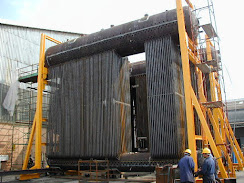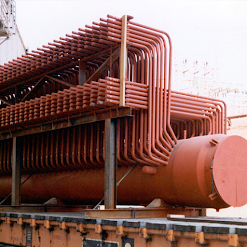THERMAL POWER PLANT BOILER TUBES
Boiler Erection of Water Tubes......
How do I find a
leak in my boiler tube?
For detecting boiler
tube leaks, plant operating engineers constantly monitor boiler furnace
vacuum, which is maintained between a -10 to -20 mm water column, feed water
flow to the boiler drum from the feed pump, which must not
abruptly increase, the de-aerator level, the quantity of makeup water, and
hissing sounds
What causes boiler tube leaks?
While leaks can occur for any number of
reasons, the main causes of boiler tube leaks are tube corrosion,
unified unit corrosion, scale, thermal shock, and improper boiler water
treatment (post-installation).
While leaks can occur for any
number of reasons, the main causes of boiler tube leaks are tube corrosion,
unified unit corrosion, scale, thermal shock, and improper boiler water
treatment (post-installation). Preventing boiler tube leaks and failures starts
with understanding why they happen in the first place.
Tube Corrosion ?
Corrosion and the
breakdown of system components are the leading causes for boiler leaks. While
this can theoretically happen anywhere within the boiler, corrosion in the
tubes themselves is the most direct cause of leaks.
Tubes can become
corroded over time due to oxygen pitting. This is where there is excess oxygen
in the boiler water itself, which causes corrosion when iron or other materials
react with the oxygen molecules. The lower the temperature of the boiler
feedwater, the more oxygen is introduced to the boiler, causing a higher risk
for oxygen pitting within the tubes. By maintaining higher temperature
feedwater, you can reduce the risk of oxygen pitting.
To help prevent
tube corrosion and oxygen pitting, it’s best to use what’s known as an oxygen
scavenger, such as Charlady’s Boiler Deoxy products. Oxygen
scavengers are chemical agents, like sulphate or bisulphate ions, that react
and combine with dissolved oxygen to form sulphate, effectively removing excess
oxygen from your system.
HOW RESOLVE PROBLEM-------
Boiler Deoxy
Oxygen Scavengers
BOILER DEOXY Series products are used to prevent damaging corrosion
and/or pits from oxygen remaining in water in boiler systems. BOILER
DEOXY Series water treatment products are designed for this specific purpose.
They will not volatilize at any pressure nor will the reaction product formed
with oxygen volatilize. Industries that would most benefit by use: Water
Treatment, Utilities, and Commercial/Industrial.
What reduces oxidation within the tubing?
Nitrogen introduced
into the piping at
only about 2 psig pressure will prevent oxidation build-up on the inside of the pipe during brazing or soldering.
Tube Corrosion
Corrosion and the breakdown of system
components are the leading causes for boiler leaks. While this can
theoretically happen anywhere within the boiler, corrosion in the tubes
themselves is the most direct cause of leaks. Tubes can become corroded
over time due to oxygen pitting. This is where there is excess oxygen in the
boiler water itself, which causes corrosion when iron or other materials react
with the oxygen molecules. The lower the temperature of the boiler feedwater,
the more oxygen is introduced to the boiler, causing a higher risk for oxygen
pitting within the tubes. By maintaining higher temperature feedwater, you can
reduce the risk of oxygen pitting. To help prevent tube corrosion and
oxygen pitting, it’s best to use what’s known as an oxygen scavenger, such as
Charlady’s Boiler Deoxy products. Oxygen scavengers are chemical agents, like
Sulphate or bisulphate ions, that react and combine with dissolved oxygen to
form Sulphate, effectively removing excess oxygen from your system.
2. Unified Unit Corrosion
Beyond corrosion occurring in specific parts of
a boiler, units can also experience unified corrosion throughout the entire
system itself. This is typically caused by low pH levels throughout the boiler.
When you have pH levels below 8, your system is
in a state of increased corrosion due to the higher levels of acidity in the
water. Even though a pH of 7 is technically neutral, you run the risk of
dipping down into acidic levels if anything goes even slightly wrong.
At Charlady, we like to see boiler systems at
pH levels of 10 or above to ensure that corrosion throughout the unit is kept
to a minimum. To increase the pH level of your boiler water, it’s best to use a
pH or alkalinity adjuster, like our Boiler pH, which is a blend of chemicals
specifically designed to adjust the pH levels of your boiler.
3. Boiler Scale
Scale is another issue that can occur within
boilers which leads to tube leaks. Having scale build up in a boiler can impair
heat transfer, leading to tube leaks as pressure increases. This can also clog
blowdown valves and pressure release valves.
To reduce scale within a boiler, chemical
softeners and scale inhibitors can be used BOILER DE-SCALE products are
formulated specifically for boiler systems, boasting the ability to solubilize
contaminants commonly found in boiler feedwater in order to provide the
greatest potential for maintaining clean boiler heat transfer surfaces.
The BOILER DESCALE line and similar products
work well in conjuncture with scheduled boiler blowdowns. This is where water
is intentionally flushed or “blown out” from a boiler to help avoid the
build-up of scale and other impurities that can form during steam evaporation.
Blowdowns also can remove suspended solids that are present within the boiler,
which helps if there are any clogs or obstructions within your boiler tubes.
Scale is another issue that can occur within
boilers which leads to tube leaks. Having scale build up in a boiler can impair
heat transfer, leading to tube leaks as pressure increases. This can also clog
blowdown valves and pressure release valves.
To reduce scale within a boiler, chemical
softeners and scale inhibitors can be used BOILER DE-SCALE products are
formulated specifically for boiler systems, boasting the ability to solubilize
contaminants commonly found in boiler feedwater in order to provide the
greatest potential for maintaining clean boiler heat transfer surfaces.
The BOILER DESCALE line and similar products
work well in conjuncture with scheduled boiler blowdowns. This is where water
is intentionally flushed or “blown out” from a boiler to help avoid the
build-up of scale and other impurities that can form during steam evaporation.
Blowdowns also can remove suspended solids that are present within the boiler,
which helps if there are any clogs or obstructions within your boiler tubes.
4. Thermal Shock
Anyone who has ever tried to wash a warm dish
with cold water has experienced the quick and potentially devastating effects
of thermal shock. This can occur when cold water is introduced to a boiler. The
resulting thermal shock can cause a boiler’s tubes – as well as most any of its
components – to burst or leak.
The solution here is to make sure that your
boiler feedwater is at the proper temperature before being added to the boiler.
Anyone who has ever tried to wash a warm dish
with cold water has experienced the quick and potentially devastating effects
of thermal shock. This can occur when cold water is introduced to a boiler. The
resulting thermal shock can cause a boiler’s tubes – as well as most any of its
components – to burst or leak.
The solution here is to make sure that your
boiler feedwater is at the proper temperature before being added to the boiler.
5. Improper Boiler Water Treatment (Post
Installation)
Picture this: a company has just spent
thousands of dollars installing a brand-new boiler and is ready to start the
boiler up for operation. To help preserve their investment, they must implement
a proper
water treatment program at this critical
junction. Running the boiler with untreated water will lead to premature
corrosion of the tubes and scaling of the system, potentially leading to a
failure of the boiler itself well before its intended life cycle. Proper boiler
water treatment is essential to maintaining the boiler and keeping maintenance
cost to a minimum. Overlooking this important preventive maintenance activity
will significantly increase downtime, as well as the overall cost of the
system.
Picture this: a company has just spent
thousands of dollars installing a brand-new boiler and is ready to start the
boiler up for operation. To help preserve their investment, they must implement
a proper
water treatment program at this critical
junction. Running the boiler with untreated water will lead to premature
corrosion of the tubes and scaling of the system, potentially leading to a
failure of the boiler itself well before its intended life cycle. Proper boiler
water treatment is essential to maintaining the boiler and keeping maintenance
cost to a minimum. Overlooking this important preventive maintenance activity
will significantly increase downtime, as well as the overall cost of the
system.
HOW TO DO TUBE CORRECTION ?
SHASHIKANT CHAUDHARI
kumarshashikant41@gmail.com





































Comments